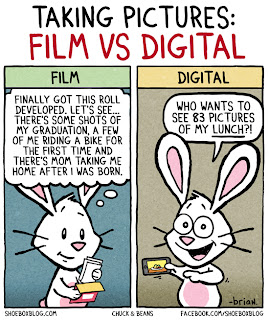Why Shoot Film in 2013?
I know I said I wouldn't take part in the discussion of Film vs. Digital but I'll need to make some comparisons in order to show the differences between the two methods. Again, to reiterate, I don't think one is better than the other. It's a matter of taste, style and process that you're interested in undertaking as a photographer that counts. Personally, I prefer film, chemical development and the darkroom for my personal work and digital for professional gigs.
What I do believe is that using a film camera will make you a better photographer no matter what.
- Getting a different look/feel from your photos
- Taking the time to actually see and feel what you're shooting
- Having no way of "chimping" so you're constantly engaged with whatever it is you're trying to photograph.
The Feel of Film
What do I mean by a different "feel"? Today, you can download software to emulate that stuff like: DXO film pack, VSCO, Film Convert, and others that are incredible at emulating film. But, these pieces of software are missing the point. You need to make a print to see and feel the differences between the two methods. Film will give you a smoother, less crisp transition between colors, lines/shapes. These days, a film print probably won't be as sharp/crisp as digital. That's the creamy, subtle, beautiful look of film (yeah, I'm passionate about that "look").
I was going to run a test and post the differences between the film and digital "look" when I came across this amazing blog post on the subject here by Marina Koslow. She mentioned Jonathan Conlas and his awesome workshops on film photography at filmisnotdead.com - I encourage you to check it out!
Slowing Down The Process
Get a piece of black construction paper, measure the dimensions of the LCD screen, cut said paper to size, now place the paper over your LCD screen and tape it in place. Now set your camera to "M" for manual and actually start to think about your settings to create a good exposure like aperture, shutter speed and ISO.
Want to know more about the subjects discussed above? Check out the awesome blog posts over at istillshootfilm.com entitled Beginners Guide to Film Photography then come back here so we can continue the conversation :)
Yes, that's right, you now know what it's like to have a film camera. Do this for a whole week and compare the shots you get with and without the LCD screen at your disposal. Also, put your camera in single shot mode so you can't hold down the shutter a la the cartoon above. I bet you're taking shots that are better composed and more present. I also bet you're seeing better/more holistically.
36 Exposures Sometimes Less
Yeah, that's all you get! 36 exposures on 35mm @ ~$5/roll is expensive per exposure we're talking 14 cents per exposure! While that cost and limited exposure count may not always on your mind, it will naturally invade your thoughts and cause you to take pause when capturing a moment. I don't know if Henri Cartier-Bresson thought about this when he was taking his pictures to capture the decisive moment but his film camera slowed him down and made him get into the action to find that moment when everything lined up, expressions were perfect, and he could convey the story he was trying to tell the absolute best way he could.
Henri Cartier-Bresson: Exposing a Gestapo Informer
This is what film photography will do for you - it will make you a better photographer - promise.
Next up: A reading list for film photographers




I am a professional web blogger so visit my website link is given below! To get more information
ReplyDeletesoftwaretube.net/
DxO FilmPack crack/